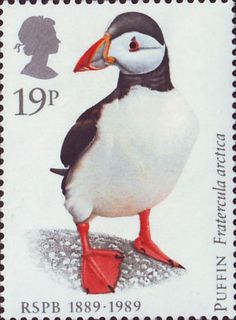The boatmen helped us scramble ashore and soon there were 50 people wandering on an uninhabited slab of sea-battered dolerite called Staple Island. It is one of the National Trust-owned Farne Islands in Northumberland and among England’s most spectacular wildlife locations. There are 100,000 pairs of breeding seabirds here and they were everywhere: at our feet, overhead, across every rock face. The stench of guano was overwhelming. While the birds seemed to be boundless, the human beings converged on the grassy knoll where the local star attraction resides. It’s the creature that adorns the boat company’s publicity and is emblazoned on the National Trust’s website for the island, the bird that possesses what the poet Norman MacCaig called the “mad, clever clown’s beak”: the pint-sized, parrot-faced puffin (Fratercula arctica).
The British love for this creature is so intense that it is, in essence, the robin redbreast of the sea. Nearly all of its breeding colonies around our coast are tourist attractions. Just across the water, along the shore from Staple Island, is the town of Amble, which holds an annual festival devoted to the puffin. From Lundy in Devon and Skomer in Pembrokeshire to the Isle of May off the Fife coast, or Fair Isle in the Shetlands, trips to puffin colonies are frequent, sometimes daily, events.
“Every tourist shop on these islands sells puffin merchandise – knitwear patterns, tumblers, carvings, coasters, cuddly toys, clothes and, of course, puffin hats,” Helen Moncrieff, the area manager in Shetland for the Royal Society for the Protection of Birds (RSPB), told me.
While the love affair is unquestionable, what seems in doubt is our ability to help the bird now that it is in trouble. Fair Isle once supported a puffin colony of 20,000 birds. In less than three decades, that number has halved. Similar declines have been reported at Britain’s most important puffin site on St Kilda, Scotland, where millions are said to have bred. Now there are fewer than 130,000 pairs, half the total recorded as recently as the 1970s.
The national picture is alarming but the news from elsewhere is even worse. Continental Europe holds more than 90 per cent – five million pairs – of the global total of Atlantic puffins but they are shared primarily between three countries: Denmark (the Faroe Islands), Iceland and Norway. Across this subarctic region, losses have been estimated at 33 per cent since 1979, when monitoring began. But the most striking figure comes from a colony on Røst, Norway, where there has been a fall over this period from nearly 1.5 million pairs to 285,000.
Source: New Statesman, 31 July 2017
http://www.newstatesman.com/culture/nature/2016/07/puffins-peril

- Login om te reageren
